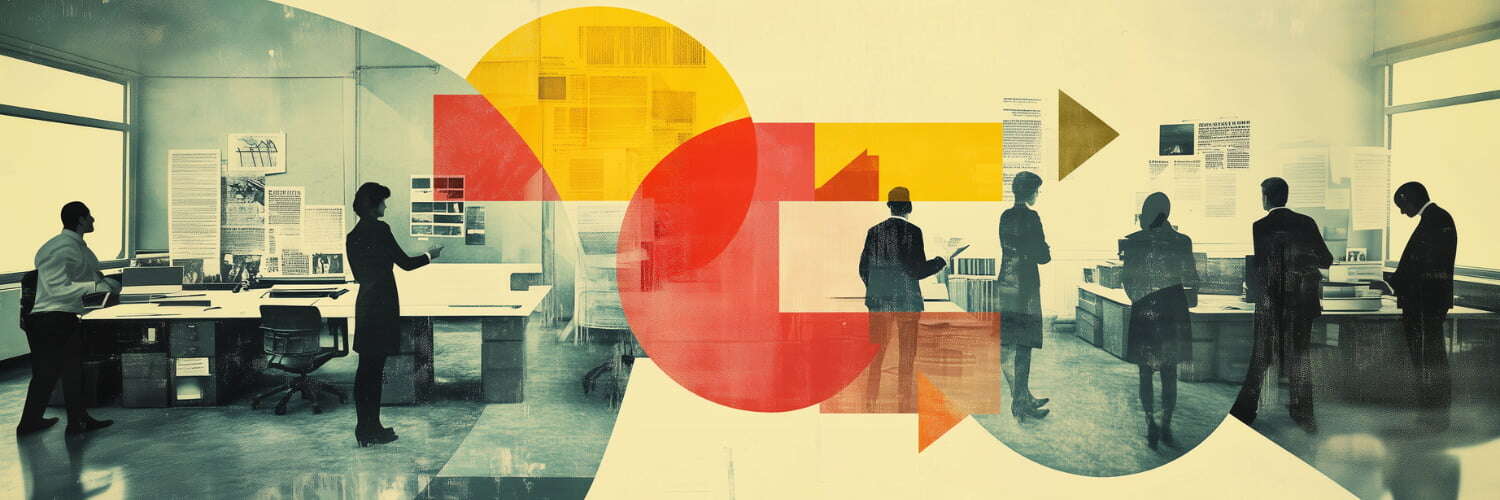In today’s business landscape, success hinges not just on individual effort but significantly on effective collaboration in the workplace.
A positive company culture, fostered through effective collaboration and inclusive practices, enhances employee engagement, satisfaction, and overall organizational success. Teamwork and the pooling of diverse ideas drive innovation and efficiency across all industries.
This being said, we invite you to unveil the intriguing concept of workplace collaboration. In the following sections, we'll delve into what 'collaboration at work' genuinely means and why it is so important. We will discuss its key advantages, including enhanced team productivity, innovation, cost efficiency, and the ability to navigate organizational challenges. Additionally, we'll provide insights into real-world examples of effective collaboration and best practices from leading companies to illustrate the dynamics of successful team engagement.
Read on!

TL;DR:
- Collaboration in the workplace is vital for driving innovation, productivity, and efficiency.
- It creates an environment where everyone feels valued, encourages open communication, and fosters teamwork.
- Collaborative efforts lead to enhanced problem-solving abilities, elevated productivity rates, and improved employee wellness and engagement.
- Continuous employee learning is stimulated through collaboration, fostering a culture of curiosity and skill development.
- Effective collaboration facilitates problem-solving and meeting efficiency and supports remote and hybrid teams.
- It creates a positive work environment, attracts top talent, reduces overhead costs, and eliminates vertical hierarchy barriers.
- Examples from leading companies like Skullcandy, Amazon, and Pixar showcase the benefits of collaboration in action.
- Innovative tools like Microsoft Teams, Slack, Trello, InVision, Tableau, and workplace experience platforms like Yarooms enhance collaboration efficiency and effectiveness.
What Is Effective Collaboration?
Effective collaboration in the workplace is more than just working together on projects or pursuing shared company goals. While those are essential elements, true collaboration is about creating an environment where every individual feels valued for their contributions and encouraged to share ideas. This kind of environment fosters open communication, mutual respect, and active participation, leading to higher levels of engagement and productivity.
Put simply, effective collaboration happens when individuals or teams leverage their diverse skills, perspectives, and strengths to achieve common goals. It’s built on open communication, shared responsibility, and respect, fostering innovation, efficiency, and collective problem-solving.
When collaboration thrives, team members feel empowered and motivated to bring their best ideas and skills to the table. This culture of mutual respect and knowledge sharing helps teams tackle challenges, align on goals, and achieve better results faster.
In essence, effective workplace collaboration isn’t just a tool—it’s a driving force for innovation, growth, and long-term organizational success.
Why Is Collaboration So Important?
At the center of every successful business is a crucial idea: collaboration. But is it so important?
We already discussed that collaboration is about bringing different minds and views together. This combination offers many advantages that can positively change how an organization works. It builds unity, encourages knowledge sharing, and leads to new ideas – vital for a thriving work environment.
When people work together, they can spot complex issues faster and develop solutions faster. It also makes it easier for businesses to adjust to new market trends or unexpected problems. So, teamwork is essential for the best performance at work. Research from around the world shows that collaboration in the workplace is critical to helping employees learn. By tackling projects or problems as a group, everyone learns new skills from each other, expanding their professional knowledge simultaneously.
Additionally, teamwork makes employees happier, which means they're more likely to stay with the company – another reason why collaboration in the workplace is essential! And not to forget, collaboration can directly improve a company's profits by making processes more efficient, reducing costs, and increasing overall productivity.
So, after considering all these points, it's clear that efficient workplace collaboration isn't just nice to have; it's necessary. Progress depends on unity, where everyone benefits and moves together towards shared success.

Benefits of Team Collaboration in the Workplace: Maximizing Performance and Innovation
The benefits of collaboration in the workplace cannot be overemphasized. When colleagues pool their talents and energy toward achieving shared objectives, they create a synergistic force that accelerates organizational performance and innovation.
Enhancing Problem-Solving Abilities
It's often stated that two heads are better than one. Collaboration in the workplace is a powerful tool for enhancing problem-solving abilities. When team members from diverse backgrounds and with different skills come together, they bring various perspectives to the table.
This diversity of thought encourages creative problem-solving and leads to innovative solutions that may not have been discovered by an individual working alone. Collaborative workspaces enable individuals to constructively challenge each other's ideas, fostering a culture where out-of-the-box thinking is welcomed and celebrated.
Elevating Employee Productivity Rates
Workplace collaboration significantly boosts employee productivity by creating a supportive environment where ideas flow freely, and tasks are completed more efficiently. When team members work together, they can divide tasks according to each individual's strengths and expertise, leading to faster completion times and higher-quality outcomes. This collaborative approach streamlines workflows and reduces the workload on any single employee, preventing burnout and fostering a healthier work-life balance.
Improving Employee Wellness and Engagement
Improved employee wellness and engagement metrics is a standout benefit of collaboration in the workplace. Collaboration boosts morale and creates a supportive environment where employees feel valued and connected by fostering a sense of unity and shared purpose.
This connection enhances their mental and emotional well-being and ignites their passion and commitment to their work. As team members collaborate, they experience more profound satisfaction and accomplishment, leading to heightened engagement and a vibrant, positive work culture.
Stimulating Continuous Learning and Knowledge Sharing Among Employees
Employee collaboration is a powerful engine for stimulating continuous learning. As individuals come together to share ideas and solve problems, they naturally exchange knowledge and skills, sparking curiosity and a desire to learn more. This collaborative environment turns everyday tasks into learning opportunities, where employees are encouraged to explore new concepts, ask questions, and stretch their abilities. In such a collaborative workplace, learning becomes an integral part of the workday.

Facilitating Overall Problem Resolution
Efficient team collaboration plays a crucial role in facilitating overall problem resolution. By pooling their collective expertise and perspectives, employees can tackle challenges more effectively than they could individually.
Moreover, the supportive nature of a collaborative workplaces encourages open communication and rapid iteration, ensuring that problems are resolved in a way that strengthens the team and the organization as a whole.
Enhancing the Efficiency of Meetings
Workplace collaboration significantly enhances the efficiency of meetings by ensuring that discussions are focused, productive, and inclusive. When team members are accustomed to collaborating, they bring a sense of purpose and preparedness to meetings, having already aligned on objectives and shared relevant information in advance. Consequently, meetings become more dynamic, engaging, and fruitful, contributing directly to the team's productivity and effectiveness.

Enhancing Efficiency in Remote and Hybrid Teams with Collaboration Tools
Efficient workplace collaboration is crucial in enhancing efficiency in remote and hybrid teams. Digital collaboration tools are essential for maintaining productivity and effective teamwork among dispersed teams.
When face-to-face interactions are limited, and practices ensure that communication remains clear and projects stay on track. Tech-powered digital collaboration minimizes misunderstandings and delays, allowing for seamless coordination and faster decision-making. Moreover, it supports a culture of transparency and inclusivity, ensuring that every team member feels equally involved and valued, whether working from home or the office.
Creating a Positive Work Environment
Workplace collaboration is a cornerstone for crafting a positive work environment, weaving a fabric of mutual respect, support, and camaraderie among employees. Poor collaboration, on the other hand, can create a negative company culture that results in disengaged employees, ultimately impacting performance and commitment.
As colleagues unite towards shared goals, they cultivate strong bonds, trust, and create efficient team dynamics. This synergy not only smooths out potential conflicts by embracing diverse viewpoints but also elevates morale through collective achievements and constructive handling of setbacks.
Attracting Top Talent to the Company
A collaborative work environment is a magnet for top talent by showcasing a company's commitment to fostering a supportive, inclusive, and dynamic culture. Prospective employees are drawn to workplaces where teamwork, creativity, and personal growth are prioritized.
Collaboration signals to potential hires that the company values open communication, shared success, and the professional development of its staff. This appeal is powerful among those who thrive in team-oriented settings and are looking for more than just a job but a place where they can be part of something bigger.
Reducing Overhead Costs
Collaboration in the workplace is a critical driver in slashing overhead costs. By fostering a culture where ideas and responsibilities are shared, companies can eliminate redundancies, cut unnecessary meetings, and make smarter use of resources.
This team-oriented approach speeds up problem-solving and decision-making and sparks innovation, encouraging employees to find creative, cost-effective solutions. The result is a leaner, more agile organization where productivity soars without the burden of inflated expenses.
Eliminating Vertical Hierarchy Barriers
Workplace collaboration is pivotal in breaking down vertical hierarchy barriers fostering a more democratic and accessible work environment. Collaboration blurs traditional lines of authority by encouraging open communication and teamwork across all levels, making leaders more approachable and employees more empowered. This shift facilitates the free flow of ideas and feedback and allows for a more inclusive decision-making process, where contributions are valued based on merit rather than position.
Boosting the Organization's Potential for Change
Lastly, collaboration in the workplace is a powerful catalyst for boosting an organization's potential for change. Collaboration breaks down silos. It encourages cross-functional teams to share insights and perspectives, leading to more innovative solutions and adaptive strategies.
This inclusive approach ensures that change initiatives benefit from various viewpoints, increasing their relevance and effectiveness. Moreover, when employees from different levels and departments work together towards common goals, it builds a sense of ownership and commitment to the change process.
Examples of Collaboration in the Workplace
Let’s discuss some examples of teamwork in action, highlighting how collaboration leads to success and innovation in the workplace.
HR and Facility Management Professionals Building Workplace Experience
A sterling example of collaboration in the workplace happens between Human Resources (HR) and Facility Management professionals. Together, they construct exceptional workplace experiences.
From an HR lens, their duty is to understand employees' needs, expectations, and culture-building activities— essentially driving an organization's 'people' aspect. On the other hand, Facility Management brings a detailed understanding of the physical environment and how it can be used effectively and kept efficient, safe, and functional.
By marrying these two perspectives, organizations build holistic employee experience strategies that streamline the way people interact with their workplaces. This balanced approach results in seamless operational administration and a thriving work atmosphere that motivates everyone in the workforce.

IT Collaborating with Department Heads to Streamline Processes
It doesn't merely end at HR and Facility Management collaborations in workplaces; one can delve into exemplary cooperation when Information Technology (IT) teams join forces with department heads across various organizational units.
This powerful alliance allows for streamlining processes across all business operations, eventually laying the groundwork for digital transformation. Utilizing project management tools can facilitate collaboration and streamline processes, enhancing communication and efficiency.
The IT personnel bring extensive knowledge about cutting-edge technology applications that could bolster productivity among team members. At the same time, department heads possess practical insights about their specific units’ challenges and strengths.
Such collaboration typically unfolds through regular meetings or think tanks wherein ideas get exchanged, issues discussed comprehensively, and future technological investments vetted meticulously - shaping a tech-empowered work ecosystem efficiently tailored to fulfill unique departmental requirements.
Facility Management: Powering C-Suite Decision-Making with Data
The strategic collaboration between facility management professionals and C-suite executives comes from an analytics-fueled decision-making strategy and managerial acumen. In this setup, facility management experts harness workplace analytics from multiple sources—utilization metrics from space management software or energy sustainability figures—and analyze them for actionable insights.
C-Suite executives then utilize these insights to make informed decisions about resource allocation, operational policies, and expansion plans. This symbiosis leads to cost-effective solutions and poses long-term strategic decisions that drive sustainable growth.
Through this collaboration, facility management professionals become the C-suite's invisible arm, helping them navigate their course toward efficiency and overall organizational success. It exemplifies how cross-function collaborations can elevate data-driven decision-making and improve both individual department performance and overarching company results.
Overcoming Collaboration Challenges
While collaboration offers numerous benefits, it also comes with its own set of challenges. Addressing these challenges is crucial for fostering a collaborative work environment. Here are some common collaboration challenges and strategies to overcome them:
-
Poor Communication: Ineffective communication can lead to misunderstandings and conflicts. To overcome this, establish clear communication channels and encourage open dialogue. Regular check-ins and updates can help ensure everyone is on the same page.
-
Lack of Trust: Trust is the foundation of effective collaboration. Building trust requires time and effort. Encourage team-building activities and create opportunities for team members to get to know each other. Transparency and consistency in actions also help build trust.
-
Different Work Styles: Diverse work styles can lead to conflicts. Recognize and respect individual differences and find common ground. Encourage flexibility and adaptability, allowing team members to leverage their strengths while accommodating others’ preferences.
-
Technology Issues: Technical difficulties can hinder collaboration. Ensure that team members are trained in using collaboration tools effectively. Regularly update and maintain technology to prevent disruptions. Having a reliable IT support system can also help promptly address any issues.
By understanding and addressing these challenges, organizations can create a collaborative work environment that encourages open communication, trust, and effective use of technology. This approach enhances team collaboration and drives better outcomes and business success.
In conclusion, effective collaboration, supported by the right tools and strategies, is essential for achieving superior workplace results. By fostering a collaborative work environment and overcoming common challenges, organizations can unlock the full potential of their teams and drive sustained growth and success.

Best Practices from Leading Companies Prioritizing Workplace Collaboration
Workplace collaboration is a cornerstone of efficiency and creativity. Adopting effective collaborative strategies can yield tremendous benefits for an organization.
Top-tier companies worldwide, such as Amazon and Pixar, have been reaping these amenities by making workplace collaboration central to their operations. Here's how:
Skullcandy's Puzzle Piece Desks: Crafting Flexible Collaboration Spaces
Skullcandy has introduced movable desks that can be likened to puzzle pieces at their international office in Zurich, Switzerland. This ingenious design allows the desks to be reconfigured to accommodate individual work or collaborative projects as needed, seamlessly transforming the workspace to foster teamwork and creativity.
The flexibility offered by these movable desks breaks down the physical barriers that traditional office layouts often impose. It encourages employees to engage with one another more fluidly and organically, enhancing collaboration and driving innovative solutions.
Such a workspace design not only supports the company's collaborative ethos but also underscores the importance of adaptability in today's fast-paced business world. Skullcandy's puzzle piece desks symbolize the brand's commitment to fostering a vibrant and cooperative workplace culture, where ideas can flow freely, and employees are empowered to work together towards common goals.
Amazon’s 'Two-Pizza Team' Rule: Enhancing Communication and Innovation
Amazon has set several market trends since its inception, and one aspect where it leads is team structure - introducing us to the concept of the ‘Two-Pizza Team.’ Every team inside Amazon should be small enough that two pizzas could satisfy the whole group. This approach is particularly effective in the context of remote work, where maintaining effective communication and collaboration is crucial.
Smaller teams significantly boost intra-team communication and collective problem-solving because each member contributes meaningfully during decision-making processes, leading to more balanced and innovative solutions. It maintains a start-up feel, encouraging fast decisions, risk-taking, and constant knowledge sharing, thus fostering an exceedingly dynamic and collaborative ecosystem.
Pixar’s 'Braintrust' Meetings: Fostering Collaborative Decision-Making
The magic behind Pixar's multiple box-office hits includes the 'Braintrust' meetings – sessions where filmmakers gather with other accomplished persons (even outside filmmaking) to examine issues about current projects openly. Critiques are encouraged but don't dictate changes, as the filmmaker has full authority on how to approach feedback.
These meetings are a platform where everyone's opinion matters, eclipsing traditional hierarchical structures and cultivating infectious collaborative energy. By decentralizing decision-making, Pixar stimulates richer discussions, enabling more diverse viewpoints to come forward, thereby guiding their award-winning storytelling towards continuous success.
In this way, these industry leaders exhibit exemplary benefits of collaboration by embracing innovative, collaborative practices that propel their organizations to new heights while maintaining a tireless commitment to promoting creativity and nurturing talent in tandem.

Innovative Collaboration Tools and Technology for Workplaces
In today's digital workplace, collaboration tools and technology are indispensable for facilitating effective collaboration. These tools enable team members to communicate, share information, and work together seamlessly, regardless of location or time zone. Here are some essential collaboration tools and technologies that can enhance team collaboration:
-
Project Management Software: Tools like Asana, Trello, and Basecamp help teams organize and prioritize tasks, track progress, and collaborate on projects. These platforms provide a clear overview of project timelines and responsibilities, ensuring everyone stays on the same page.
-
Communication Platforms: Slack, Microsoft Teams, and Google Workspace enable real-time communication and information sharing. These platforms support instant messaging, video calls, and file sharing, making it easy for team members to stay connected and collaborate effectively.
-
Video Conferencing Tools: Zoom, Skype, and Google Meet facilitate virtual meetings, allowing remote teams to collaborate in real time. These tools support video calls, screen sharing, and recording, making conducting productive meetings from anywhere easy.
-
File Sharing and Storage: Dropbox, Google Drive, and Microsoft OneDrive enable team members to share and access files from any location. These tools ensure everyone can access and collaborate on the latest documents in real-time.
-
Digital Whiteboards: Mural and Google Jamboard provide virtual spaces for brainstorming and idea collaboration. These tools allow team members to visualize concepts, create mind maps, and collaborate on ideas dynamically and interactively.
Additionally, full-fledged workplace experience platforms like Yarooms foster collaboration at both employee and manager levels. These platforms collect valuable workplace data (utilization, visitor, sustainability analytics) that facility managers can share with C-suite executives to empower their decision-making. It provides both HR and Facility teams with a comprehensive view of how people interact with the workplace while allowing employees to schedule their work, gain visibility into colleagues' availability, and easily book workspaces for teamwork. Implementing such tools can significantly enhance workplace collaboration.
Concluding Thoughts: The Transformative Impact of Workplace Collaboration on Organizational Success
Collaboration in the workplace is more than a buzzword; it's a key driver of team effectiveness, innovation, and growth. In today's dynamic business environment, success demands collaborative efforts, where combining capabilities leads to superior collective intellect. This approach, involving both internal cross-functional teams and external partnerships, is becoming essential for staying ahead.
Moreover, workplace collaboration plays a vital role in enabling organizational change and agility by breaking down hierarchical and operational silos, making businesses more responsive and innovative. Beyond tangible benefits like increased productivity and cost savings, collaboration also offers significant intangible rewards. It encourages continuous learning and knowledge sharing among employees, enhances wellness, and boosts engagement, positively affecting workplace culture.
Success stories from companies like Skullcandy, Amazon, and Pixar underscore that effective collaboration strategies can yield competitive advantages. Modern tools facilitate efficient teamwork across distributed teams, aligning well with the current trend of hybrid work models.
Collaboration fosters comprehensive workplace transformations, setting the stage for long-term success. However, each organization must tailor its collaborative strategies to fit its unique ethos and the demands of the situation.
![Benefits of Collaboration in the Workplace [+Collaboration Examples]](https://www.yarooms.com/hubfs/Benefits%20of%20Collaboration%20in%20the%20Workplace%20%5B%2BCollaboration%20Examples%5D.png)











